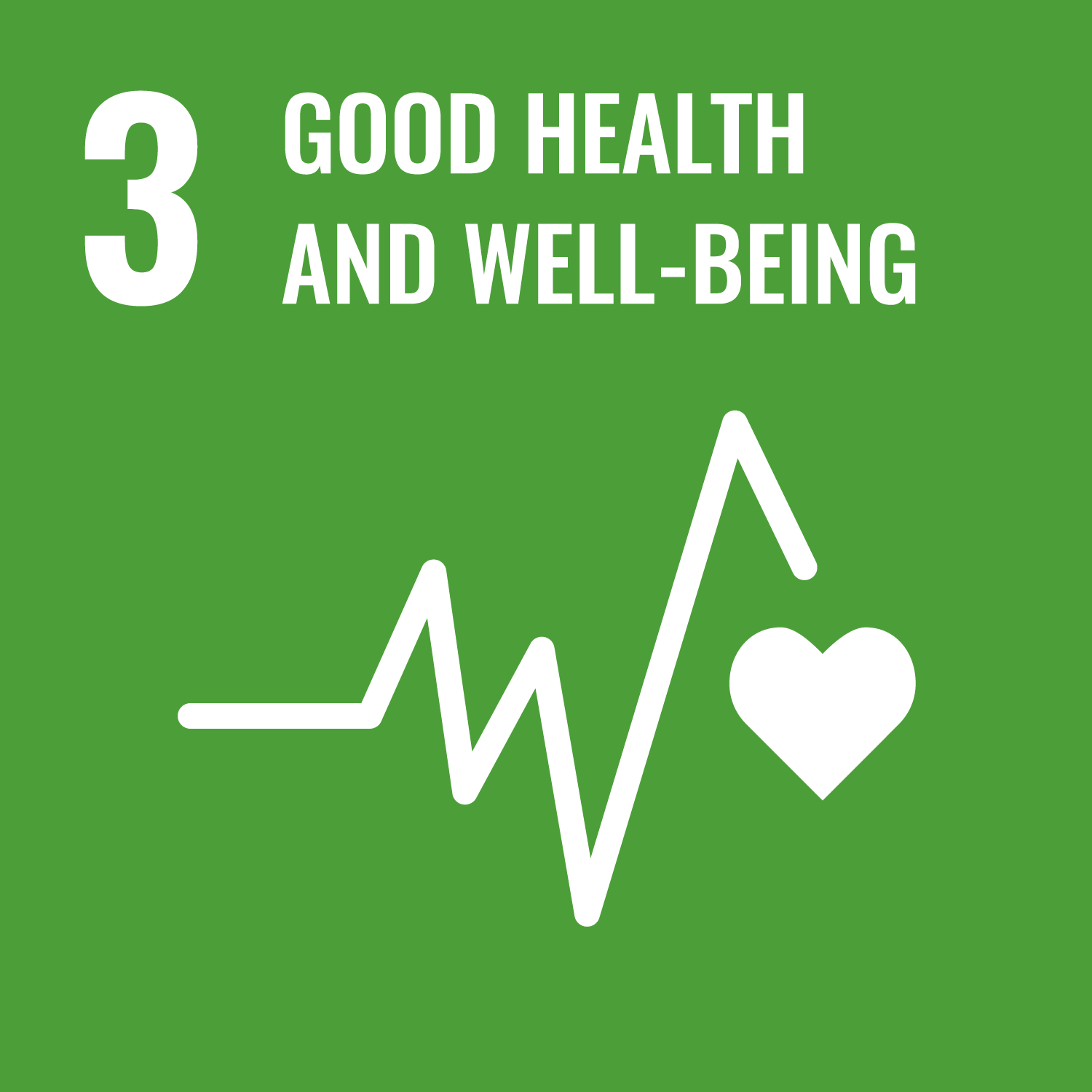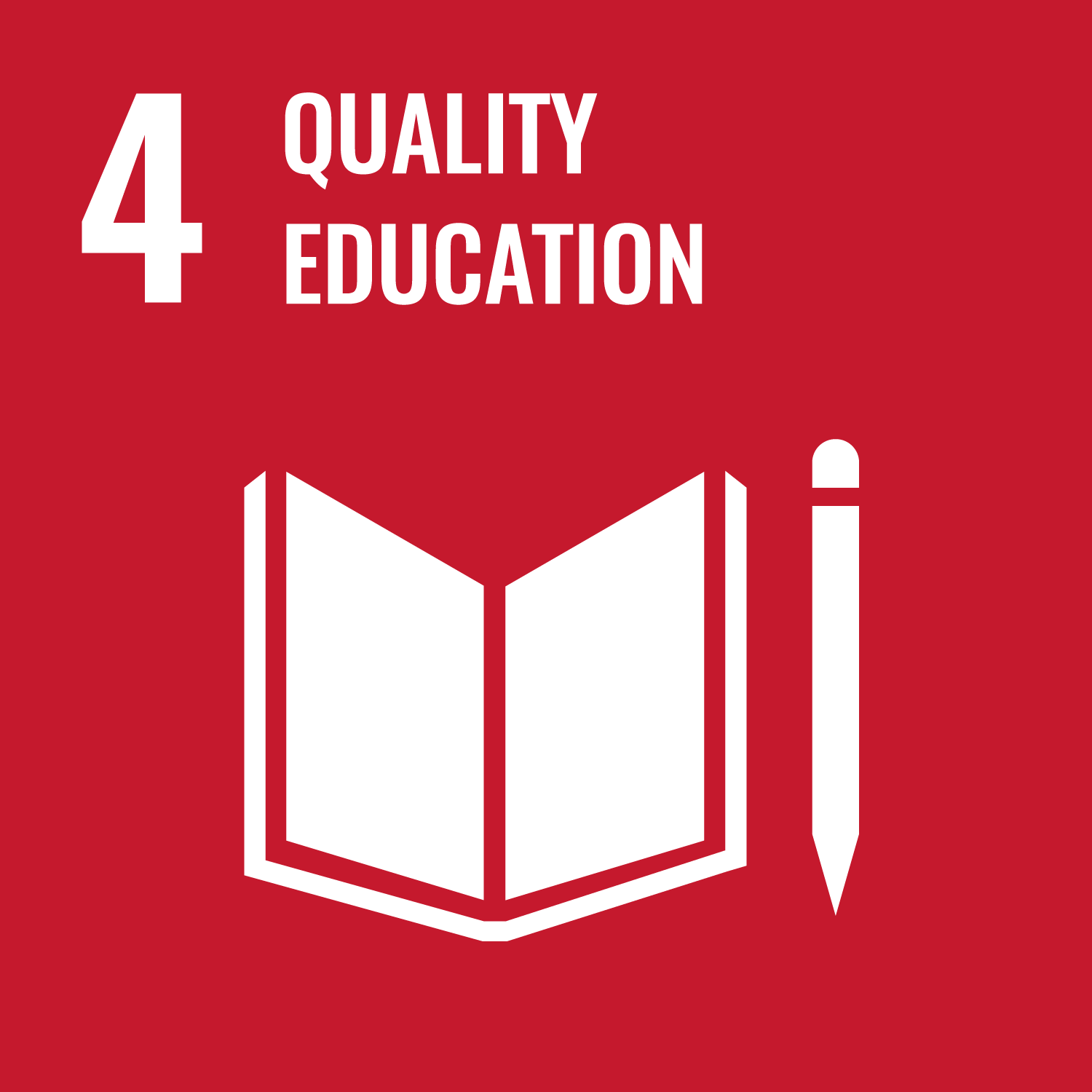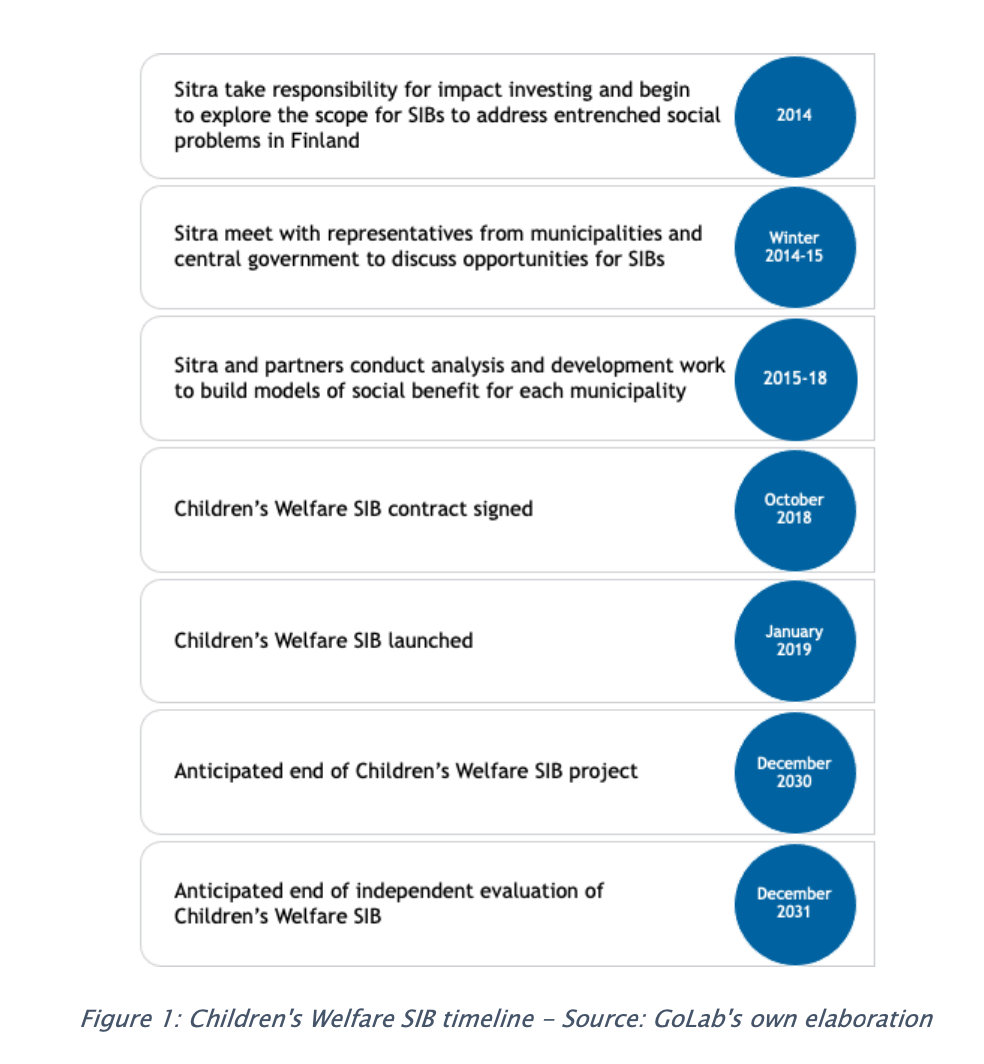
- Impact bond
- Child and family welfare
- Europe
Finland
10 mins
Children’s Welfare Social Impact Bond, Finland
Last updated: 16 Jul 2021
- Children’s Welfare Social Impact Bond, Finland
- SDGs and project locations
- INDIGO Key facts and figures
- The problem
- The solution
- Development & Implementation Process of the Social Impact Bond
- Structure and pledged resources
- Specifics of Contractual Arrangements
- Results so far
- Reflections and Lessons Learned
- Downloads and resources
- Children’s Welfare Social Impact Bond, Finland
- SDGs and project locations
- INDIGO Key facts and figures
- The problem
- The solution
- Development & Implementation Process of the Social Impact Bond
- Structure and pledged resources
- Specifics of Contractual Arrangements
- Results so far
- Reflections and Lessons Learned
- Downloads and resources
This case study takes a close look at the Children’s Welfare Social Impact Bond (SIB) in Finland, which aims to improve the wellbeing of children, young people and families in five municipalities in the country.
Project Location
Aligned SDGs


INDIGO Key facts and figures
-
INDIGO projects
-
Commissioner
-
Intermediary
-
Investor
-
Provider
-
Target Population
- Children and youth people and their families in need of welfare support
-
Capital raised (minimum)
EUR 10.10m
(USD 5.73m)
-
Service users
400
-
Duration
12 years
-
Maximum Outcome Payments
EUR 10 - 12 million
The problem
Sitra, the Finnish Innovation Fund, is an independent public fund and a think-and-do tank. It works under the supervision of the Finnish Parliament to promote the welfare of Finnish society. In 2014, Sitra began to examine opportunities for impact investing, including social impact bonds (SIBs) in Finland. As a result, in the winter of 2014-15, representatives from Sitra engaged with around 150 of Finland’s 310 mayors, as well as to various ministries of the national government. They introduced these public officials to the concept of a social impact bond and asked the policymakers in which areas the instrument could most effectively be utilised. From those discussions, a clear theme emerged. Most mayors identified the wellbeing of families as one of the most difficult challenges for municipalities to address. Central government echoed their concerns, highlighting the importance of family wellbeing to the future of Finnish society.
According to the Central Union for Child Welfare, child welfare and protection services in Finland are primarily remedial. As a result, by the time children come into contact with the service, they have likely already suffered some kind of harm. In addition, these services are expensive, with the highest costs associated with foster care. This cost is borne by municipalities, who are responsible for the provision of child welfare services.
A preventative approach, therefore, promised a win-win scenario: harm to children would be averted and the cost of child welfare service to municipalities would be reduced. However, with existing high levels of spending on child protection, municipal authorities lacked the resources to support a transition from remedial to preventative approaches. The social impact bond model, in which the upfront cost of service delivery is covered by private investment, offered a means to fund novel preventative services without impacting on the funding required for remedial services in the short term. If pre-specified outcomes are achieved, the municipality should save money on the cost of remedial services. Part of this saving will be used to repay the investment fund, with interest, meaning that the public sector only pays for outcomes that are achieved.
The solution
The overall objective of the Children’s Welfare SIB is “promoting the welfare of children, young people and families with children”. Within the SIB, programmes are commissioned by five municipalities: Helsinki, Hämeenlinna, Kemiönsaari, Lohja and Vantaa. In each municipality, the needs of children and families vary significantly. As a result, more specific objectives, target groups, service particulars and performance indicators also vary. In order to develop bespoke target outcomes, the team at Sitra worked with each municipality to model social benefit, based on their particular need.
In Helsinki, a total of 200 children and their families will be selected to participate in the service between 2020 and 2024, with 1-3 years of service provision on average. The target group is defined as a child aged 3-6 with more than one behavioural, social or emotional difficulty, whose parent is uneducated or absent from work and faces additional difficulties in parenting or their life situation. Services include individual support to the child and family, group activities, and community and peer group activities. Target outcomes focus on the use of eight child protection services and one special support service for school pupils. If the child has not used these services, the city will pay the fund its performance bonus, with service use monitored until 2032.
In Hämeenlinna, the first municipality to join the SIB, activities are based on the Icehearts model. The city had a reputation as one of the most family-friendly cities in Finland. However, they were also experiencing increasing numbers of children in out-of-home care, suggesting that they were not doing as well as they thought. They identified a particular need for families with small boys, who were not doing as well as those with girls.
The programme selected families with 6-year-old boys, based on four different risk factors. These families will be supported for 12 years, until the children reach adulthood at 18 years old. The final payments for outcomes will come at the end of the 12 years, depending on whether the service users are in education or employment, having avoided ‘afterwards services’ and exclusion from normal life. However, there will also be interim payments throughout the 12-year programme period, based on usage of “heavy” social and health services. If actual usage of these service by programme participants is less than expected based on historical data, a portion of the cost savings from these services will be paid to the investment fund.
Kemiönsaari targets children under 7 with regulatory or developmental challenges, whose parents have a ‘risk factor’ including single parenthood, low socio-economic status, or mental health problems.
In Vantaa, the SIB is focused on families with a child with neuropsychiatric symptom and primarily delivered through the Family Partner model developed by SOS Children’s Village. Family Partners work closely with families, helping to identify gaps in service provision early and responding to these needs early to prevent challenges piling up.
In addition, families receive a needs assessment through social care services to identify any other appropriate services. Lohja also makes use of the Family Partner model, and targets children aged 5-8 with regulatory challenges whose parents also face challenges.
Development & Implementation Process of the Social Impact Bond
Following the early discussions between Sitra and various representatives from local and national government in Finland, a decision was taken by the team responsible for the development of impact investing within Sitra – and in particular, piloting the SIB model – to develop a Children’s Welfare SIB. Following this decision, information was circulated to those municipalities who had shown interest in this kind of project during exploratory conversations. Of these, Sitra held further discussions with between 10 and 20 municipalities, before ultimately five municipalities decided to proceed with the project.
A similar process was involved in bringing together investors for the project. Initially, Sitra approached a range of investors informally, to introduce the idea of impact investing and the SIB model and gauge their interest. Based on the tendering process, in accordance with procurement legislation, FIM was then selected as the asset and programme manager for the project, and investors were approached more formally to invest in the project fund.
The contract between parties was signed in October 2018, and the Children’s Welfare SIB was launched in January 2019. Timelines for programme delivery vary by municipality. For example, the SIB will run for 12 years in Hämeenlinna, but only six years in Vantaa. In Helsinki, service users will be taken on between 2020 and 2024, for an average period of 1-3 years, with impact monitoring for outcome payments continuing until 2032.

Structure and pledged resources
The Children’s Welfare SIB is jointly managed by FIM, the main partner and fund manager, and the Central Union for Child Welfare, responsible for programming, including the selection of service providers and decisions surrounding local operations. When the first social impact bond in Finland was launched, an Occupational Wellbeing SIB, Sitra had hoped that traditional investment fund managers could learn to manage social services and play the role of programme manager. However, this did not materialise in that earlier project – it appeared that asset managers were not able to learn to speak the public sector language.
Based on this experience, Sitra approached the Central Union for Child Welfare (LSKL), a Finnish NGO with a mission to “develop child welfare and to promote cooperation between non-governmental organisations, municipalities and state authorities”. Sitra made introductions between the Union and FIM, which ultimately led to the formal involvement of the NGO on the project.
Investors contribute to the project through a private equity fund, administered by FIM, through which services are financed. The fund raised a total of EUR 5 million as of January 2020, with investment from eight Finnish organisations, including the S Group, LähiTapiola, Sitra, the City of Espoo, Samfundet Folkhälsan and Tradeka.
The five municipalities involved in the SIB (Helsinki, Hämeenlinna, Kemiönsaari, Lohja and Vantaa) each pay for outcomes that are achieved in their programmes. In total, there is a maximum possible outcome payment of EUR 10-12 million. The maximum outcome payment for each municipality varies.
The lead providers – SOS Children’s Village and Icehearts – implement interventions for children under the SIB. Other implementing partners may deliver particular interventions during the project as appropriate. There are around 5-7 organisations involved with supporting the lead providers.
An independent evaluator, THL, the Finnish Institute for Health and Welfare, has been appointed by Sitra. The independent evaluation looks at features of the SIB, such as outcomes measurement, in order to inform and develop future implementation. The role of the independent evaluator is described below.
In addition, Sitra was involved at various stages of the project in a range of roles, from initial scoping to outcomes modelling and organising stakeholders to outcome development and funding the evaluation.
Specifics of Contractual Arrangements
While the contractual structure of the Children’s Welfare SIB is that of a single social impact bond, it is in many ways five distinct projects. Each of the five municipalities have different agreements surrounding providers, cohorts, outcomes metrics and targets.
However, the single SIB structure was more appealing to investors as from their point of view, the risk is shared across a range of different approaches in different municipalities rather than investing in a single municipality where the approach may fail.
In addition, the single structure – with FIM as overall project manager, and the Central Union for Child Welfare leading on service delivery – was crucial to delivering an effective intervention. The Union provided valuable expertise in identifying appropriate service providers and overseeing their work, ensuring that the modelled societal benefit could be delivered in practice, while FIM provided their own expertise in overseeing the financial aspects of the project. Even with strong modelling and design, without effective project management from these organisations, the SIB would likely not have been successful.
Adopting this approach, with a single project and fund manager unit across multiple sub-projects, may also have reduced transaction costs and the time required to develop individual municipal programmes.
Results so far
At the time of writing, it is still relatively early in the Children’s Welfare SIB’s lifecycle. Service provision started in January 2019, and the project is not expected to conclude until December 2030. As a result, there are no formal results to report at this stage. However, early anecdotal evidence does appear promising – in Hämeenlinna, for
example, some cost savings have already been achieved, and as a result, payments have begun to be made to the investment fund. There has also been positive feedback from families participating in the programme in Vantaa.
An external evaluation of the overall Children’s Welfare SIB project has been commissioned, partly by Sitra. It will be conducted by THL, the Finnish Institute for Health and Welfare. THL is running a longitudinal study to examine the cost- effectiveness of preventative children’s services, as well as the suitability of social impact bonds as a funding mechanism for them. This evaluation is an external one and is not connected to the payment mechanism of the SIB. The SIB itself is designed with payment mechanisms tied to the modelling of societal benefits, with the intention that these indicators are so clear so as to not require an external evaluator.
Specific investigation objectives of the evaluation include:
- The cost-effectiveness of operating models funded by the SIB
- The effects of activities on the psychosocial well-being of children
- The suitability of the SIB for the financing of preventative work in municipalities and regions
The start of the study coincided with the launch of the SIB in January 2019, and the evaluation is planned to run until the end of 2031.
Reflections and Lessons Learned
The role of Sitra as an orchestrator
Sitra, the Finnish Innovation Fund, played a key role throughout the development and implementation of the Children’s Welfare SIB. This included:
- Acting as a convenor for discussion surrounding new ways of funding proactive and preventive welfare services
- Identifying the potential of a SIB to address challenges facing children’s social and health services
- Data analysis to understand the scale of the problem
- Linking municipalities with investors
- Helping municipalities to model the social benefits and target outcomes most
appropriate to their need
Sitra were a driving force in delivering the project, and played a coordinating role that is vital in many social impact bonds. SIBs are complex projects, involving many actors whose interests may diverge. An orchestrator like Sitra can help to overcome challenges, provide expertise, and ensure the interests of parties are ultimately aligned. Building on the success of the Impact Investing team within Sitra, in 2020 the Finish government, established a national Centre of Expertise for Impact Investing at the Ministry of Economic Affairs and Employment, whose main role is to assist public sector actors in developing outcomes contracting approaches.
Of course, SIB projects can be initiated by a range of different stakeholders. They may start with the outcome payer, such as a government department, recognising a particular underserved population or a need to bring a greater focus on outcomes for a particular group. Alternatively, a service provider may believe they have developed an innovative solution to a social issue and therefore seek financing to deliver it through a SIB model. The development process does not necessarily require an orchestrator. However, they can be fundamental in driving forward the SIB, especially in situations where there is limited capacity and/or expertise within the outcome payer to lead the development process.
Organisations such as the Centre of Expertise for Impact Investing within the Finnish Ministry of Economic Affairs and Employment (previously within Sitra) also play an important role in the longer term, beyond the development of individual projects. By acting as a hub of expertise, they can help to raise awareness, gather data and learning, and convene stakeholders across sectors to share best practices.
- Acting as a convenor for discussion surrounding new ways of funding proactive and preventive welfare services
Reducing complexity in SIBs with multiple commissioners
While the Children’s Welfare SIB is one legal entity, it is effectively five individual programmes delivered under a single financing arrangement. Each of the municipalities involved faced different specific challenges under the broader theme of the welfare of children and their families. As a result, Sitra worked with each municipality on modelling the specific social benefit they wanted to achieve through the project. This resulted in five different programmes, with different groups of service users, interventions and target outcomes, in order to address the need of a particular municipality. This approach helped to ensure a robust outcomes framework, which - among other factors - requires alignment between payable outcomes and policy objectives.
A study by researchers at Tampere University examined the Children’s Welfare SIB in two municipalities. It highlights a number of observations from interviews with project stakeholders, including the potential for the SIB to facilitate more flexible and client-oriented services.
As noted before, delivering the different municipality programmes under a single overarching SIB framework offers a number of potential benefits. By spreading investments over a number of programmes, the impact on investors of a particular approach being unsuccessful was reduced, offering a more appealing risk profile to investors. In addition, the single SIB structure minimises the number of separate contracts that need to be negotiated, likely reducing transaction costs when compared to five individual SIB projects. This offers a potential model for others to explore when developing multiple projects at the same time – by combining programmes into a single SIB, it may be easier to achieve the scale required to attract investors and/or minimise transaction costs, while still addressing the different needs of particular service user groups.
Children’s Welfare SIB II
In spring 2019, the planning for the Children’s Welfare SIB II project was launched. This follow-up project will involve four new municipalities, each of whom was interested in the initial Children’s Welfare SIB, but for various reasons were not able to join the project before it launched. The Children’s Welfare SIB II project builds on the principles of the first SIB, in particular learning from the experience of the initial project’s social benefit modelling to expedite this process. However, given the bespoke nature of the approach, significant work was still required to develop the model for each new municipality’s programme.
Following a procurement process, FIM was selected in summer 2020 as the asset and programme manager for the project, together with the Central Union for Child Welfare. Contracts between four municipalities and FIM were signed in November 2020 and practical operations are planned to start during spring 2021.
References
- SITRA: Children SIB
https://www.sitra.fi/en/cases/children-sib/
- CENTRE OF EXPERTISE FOR IMPACT INVESTING, Ministry of Economic Affairs and Employment of Finland
https://tem.fi/en/centre-of-expertise-for-impact-investing
- ANNI KYÖSTI AND JENNI AIRAKSINEN, Tampere University: Future of Well-being Services at a Crossroads – Towards Outcomes Contracting?
Downloads and Resources
Download the Case Study Report
Download PDF